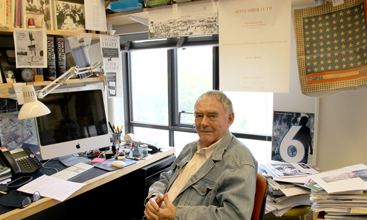Course Overview
This page focuses on the course 4.241J/11.330J Theory of City Form as it was taught by Prof. Julian Beinart in Spring 2013.
This course that has been offered every year at MIT since 1956. First developed and taught by Prof. Kevin Lynch, the course was then adopted by Prof. Beinart, who has taught the course for the past 36 years. This advanced-level course is intended to present various theories of city form, along with appropriate case studies, in order to build students’ understanding of urbanism and architecture and to enable them to apply such considerations in future practices.
Course Outcomes
Course Goals for Students
- To explore in depth the history and development of city form by building upon foundational knowledge from previous coursework and examining multiple case studies
- To draw connections between urbanism and architecture, as well as historical, social, and economic influences
- To formulate one’s own perspective on and understanding of city form, and to be confident in incorporating these into professional practice
Possibilities for Further Study/Careers
Students are expected to continue their work in architecture and urban studies. Many of the graduate students already possess a professional background in these fields of study.
Instructor Interview

Prof. Beinart in his office, surrounded by materials from both teaching and practice. (Image courtesy of MIT OpenCourseWare.)
In the following pages, Prof. Beinart describes various aspects of how he teaches 4.241J/11.330J Theory of City Form.
- Adoption and Adaptation
- The “Theory” in Theory of City Form
- Key Aspects of the Course
- The Influence of the Present
Below are links to videos produced by Prof. Lynch as part of his studies into the theory of city form and of human perceptions of the city.
- “Full Day” (1958): a time-lapse film showing 24 hours as viewed from the Memorial Drive side of the MIT campus
- “View from the Road” (1965): a high-speed film taken from a drive around the Cambridge-Boston area
Curriculum Information
Prerequisites
- 11.001J/4.250J Intro to Urban Design and Development (undergraduate) or
- 11.301J /4.252J Intro to Urban Design and Development (graduate)
Requirements Satisfied
- H-Level Graduate Credit

- Required for SMArchS
Offered
Every spring semester
Student Information
Enrollment
30 students
Breakdown by Degree Program
1/3 Master of Architecture, 1/3 Master of Science in Architectural Studies, 1/3 other graduate programs
Breakdown by Major
2/3 from Department of Architecture, 1/3 from Department of Urban Studies and Planning
Typical Student Background
Students possess varying academic backgrounds and work experience, but share common knowledge in urbanism. The class demographic, on occasion, includes undergraduates, cross-registered students, and visiting scholars.
Ideal Class Size
Because the course is lecture-based, class size is not restricted. In the past, enrollment has ranged from 25 to 50 students.
How Student Time Was Spent
Students had the option of enrolling in this class for either 9 or 12 credits. Those enrolled for 12 units were expected to spend more time working on their term paper outside of class. During an average week, students were expected to spend either 9 or 12 hours on the course, dependent on the number of units enrolled, roughly divided as follows:
Lecture
- Two 1.5-hour lectures per week; 26 class sessions total
- Lectures include an hour of the professor’s discourse, followed by showing of slides.
- Slides include visual examples demonstrating the discussed theories and case studies.
Out of Class
- Readings in preparation for class sessions
- Term paper (length and topic dependent upon number of units enrolled)










